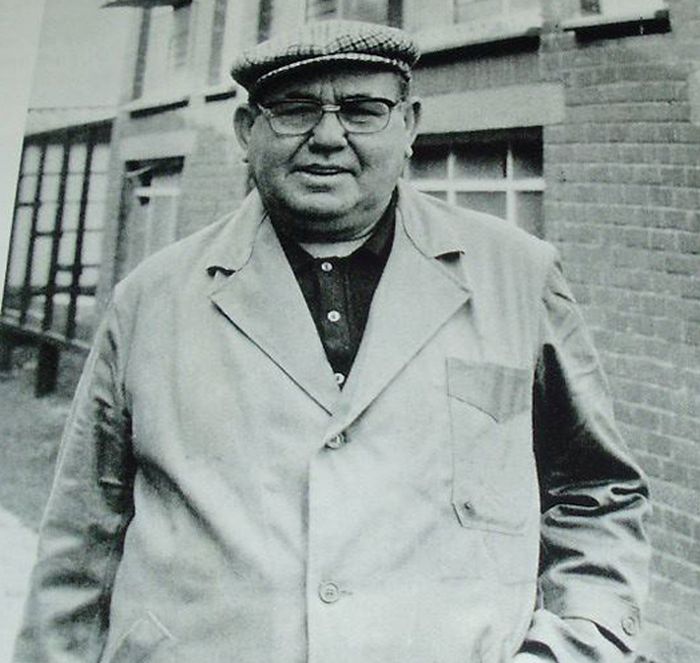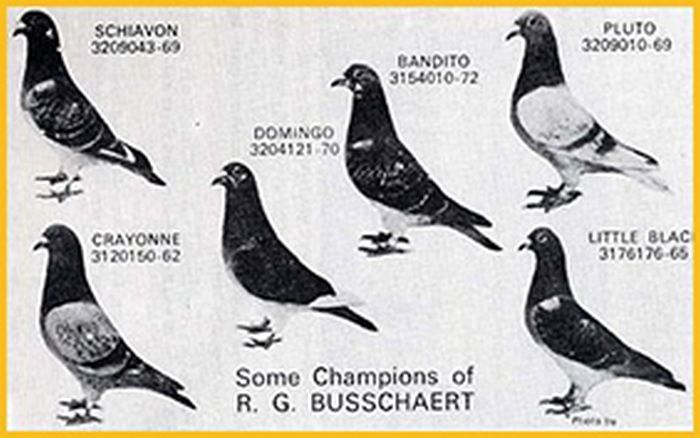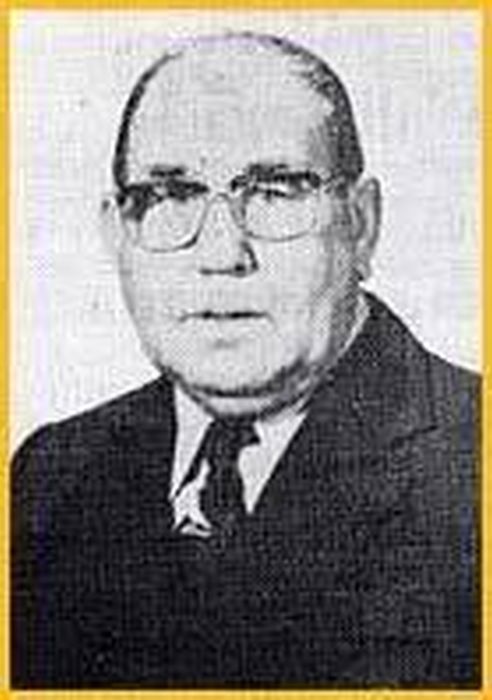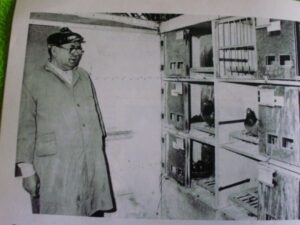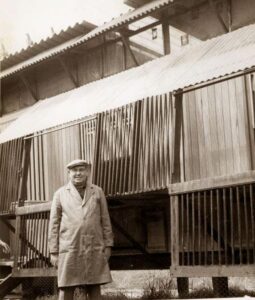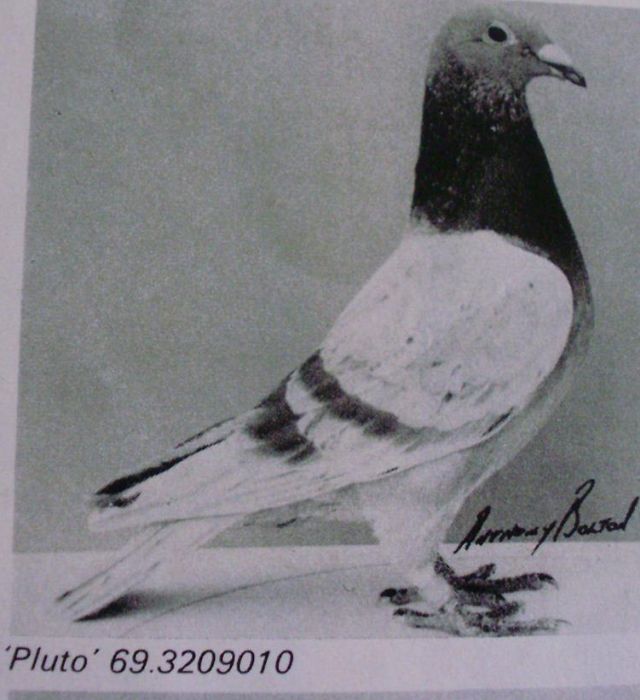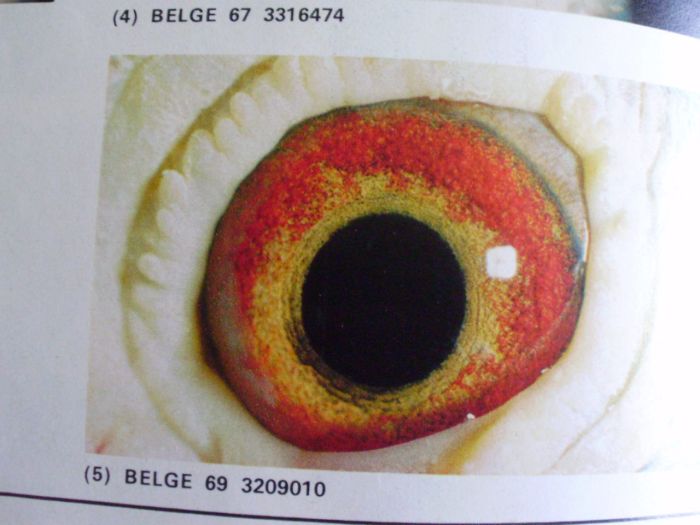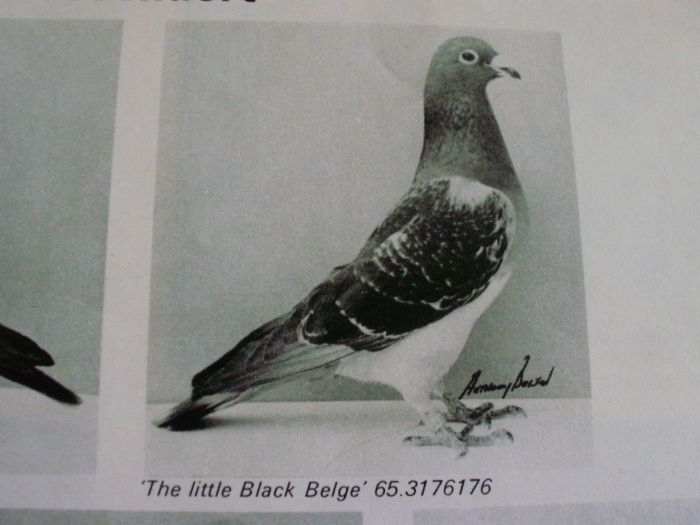Georges Busschaert
Georges Busschaert - Master Breeder was born 12th May 1911, in St Lodewijk-Deerlijk Belgium.
- brainstormmedia
- March 18, 2021
- 12:08 pm
Watch, Listen or Read about Georges Busschaert below.......
Remi (Georges) Busschaert was born into a wealthy industrial family, a family that also had a passion for the sport of pigeon racing. His father was a respected pigeon fancier and it was inevitable that the young Georges would also develop an interest. His brothers Andre and Marcel were also keenly interested as was his sister Alice. At the end of the 1920’s the Busschaert family moved to Beveren – Leie where they established a haulage business. At the same time, they invested heavily in racing pigeons from various sources. Maurice Delbar, Vandevelde, Stickelbout and Commines just to name a few.
When Alice got married to Albert Nuttyens, Georges found in his new brother-in-law a new racing partner and together they bought several birds from auction. a mealy Commines and a pigeon called Tito from Hector Baele of Scheldewinke. They bought De Plattekop from Vandevelde and sons and daughters out of ‘The Coppi’ and ‘Witterugge’ from Michel Nachtergaele of Zulte. George later borrowed ‘The Coppi’ to pair to the daughters of ‘Tito’. They later also bought the pigeon called ‘De Fijnen’ from Michel Nachetregaele.
When the Busschaert family decided to expand their business by opening a carpet factory in Kent, England, it was decided that George should be the one to move to England and oversee the project. It was inevitable that being from Belgium George’s passion for pigeon racing would see him set up lofts at his new home. The birds he stocked were bred by his brother-in-law Albet and he also obtained birds from his brother Albert who ran the familes carpet-weaving factory in Deerlicjk Belgium. These were all birds from families that George was very familiar with and ones he believed would be competitive in England.
George struck up a friendship with Gil Duncan of Deal. They went into partnership and George’s pigeons soon set the racing scene alight with their wins. They bred pigeons such as ‘The Crack’, ‘The Coppi cock’, The Great Coppi’, The Bonten’, ‘The Blesse’. Between 1956 and 1962 they won over 150 first prizes often taking the first three in the fed. Soon people started to take notice of these fantastic sprint pigeons and they started to buy them. “Why did his pigeons make such an impact on the racing scene in Britain and why have they stood the test of time and seen many other strains come and go?”
Well, you must go back in time to what the racing scene was like in Britain all those years ago. After the war and into the fifties there was not a lot of money about, especially for pigeons. In the ’60’s, times changed, there was a boom and as Prime minister Macmillan said, “You’ve never had it so good”. However, despite this newly found affluence most pigeon fanciers kept small teams of pigeons in back garden lofts. They are nearly all raced natural and they raced predominantly traditional families of pigeons that were either handed down from their fathers or bought and swapped locally. Race programs were typically mixed, short races, building up in length throughout the race program to longer ones at the end of the season. Pigeons were thus bred and selected to be good ‘all-rounders.’
 “Why did his pigeons make such an impact on the racing scene in Britain and why have they stood the test of time and seen many other strains come and go?”
“Why did his pigeons make such an impact on the racing scene in Britain and why have they stood the test of time and seen many other strains come and go?”
In Belgium however at the time, things were very different. There were specialised race programs. Races were being separated into short, middle distance and long-distance races. Specialised clubs were springing up. Fanciers were also concentrating their selection to pigeons to race predominantly short sprint races. There was a strong gambling culture and good prize money could be won. This drove a desire to obtain the best pigeons for the job, auctions sprang up to fuel this desire for more and faster pigeons. Champion pigeons were soon snapped up by the more wealthy to be put into their lofts.This is where Georges Busschaert comes onto the scene. He was effectively a rich man, he had come to England and he had a passion for fast pigeons. On his visits to Belgium to obtain pigeons, he had a very big advantage. He knew the language, he knew the Belgium pigeon-racing scene, and he knew what pigeons were the best at the time, and he bought them. He also had contacts through his brother and brother-in-law. It is rumoured that he would travel to many successful lofts simply to buy their champion pigeon. He would then bring them to England and set them up in his loft. He soon made a big impact. He started to win everything. He had introduced fast sprint pigeons using widowhood methods on pigeons that had been selected from years and years of widowhood racing. At the time the English fancier was using predominantly what effectively were just homers on the natural system, which was simply no match. The old English strains were absolutely slaughtered in all types of races.
Georges Busschaert also had this talent of being able to pick pigeons that would breed together to produce outstanding pigeons. This was not just a case of being rich and simply buying top pigeons from winning lofts and putting them together, although this did help. What also helped was that Georges Busschaert had this great sense of stockmanship. He would chose pigeons of the same shape and form, and he could identify in pigeons, qualities that he knew would blend in, but also be passed down throughout the generations. In addition to all this, his pigeons were breeding champions through what geneticists call heterosis. This is hybrid vigour.
 “Georges Busschaert also had this talent of being able to pick pigeons that would breed together to produce outstanding pigeons.”
“Georges Busschaert also had this talent of being able to pick pigeons that would breed together to produce outstanding pigeons.”
This usually occurs when highly inbred strains are crossed, but the reason Georges Busschaert could produce it in his pigeons is that there was a massive pool of winning qualities that were all different, in all these interbreeding pigeons. It was these winning genes that would produce excellent racing characteristics that kept reappearing throughout the lines. So for example you would have pigeons that won because they had fantastic cardiovascular systems, some that had perfect wing formation, others with super efficient metabolisms, others with fantastically powerful musculature. It was these individual characteristics that kept emerging and reemerging sometimes one at a time, sometimes two or more qualities together, that kept making champions.
The whole family was not inbred at all it was a family of maximum outcrossing but what made it work was that there were no bad genes to get in the way of producing champions. The chromosomes were packed with genes that could only produce these winning characteristics, different winning characteristics in each subsequent generation. This is why fanciers with distance Busschaerts would suddenly start to throw pigeons that won short sprint races and sprinters that would suddenly breed distance pigeons. Furthermore this was all fuelled even more when people started to cross them with their own strains, their own old winning lines. You now had these qualities that had been selected and honed by the British fancier being added to the continental Belgium winning characteristics.
That is why they turned out to be so versatile. They would win from 60 miles they would win from 500 miles. They would win in a strong headwind they would win in a blow home. You could race them widowhood you could race them natural. They won as youngbirds and straight away were winning as yearlings and old birds. So fliers even today are winning classic races with them when they are up to 7 years old. The other element that made the Busschaerts so versatile at all distances was that Georges Busschaert did not solely select short distance sprint pigeons, his later acquisitions were equally capable of flying the distance. Fanciers were purchasing offspring from these distance lines and crossing them with the original sprint-middle distance Busschaerts.
This diversity of champion blood also explains why the Busschaerts cannot be described as an inbred family of pigeons and why they came in all shapes and sizes and colours.
In 1960 Busschaert returned to Belgium. A new phase in the Busschaert began. This new family of Georges Busschaert birds was dominated by two cocks, Old Sooten & the Klaren. In odd instances he slipped in a pigeon through the Rosten. This pigeon was Pluto a good winner for him. He was through the Klaren on his dam’s side & was therefore a related pigeon. The other pigeon sometimes in at the base was a cock named Jonge Shonen. He was the grandsire of Rapido through the dam and comes up twice in the hen of the Goldmine Pair. The Cock is a combination of Sooten & Klaren only & the pair are therefore totally dominated by these two cocks.
It is this basic thread or pattern that is intriguing. Certain pigeons become familiar by the number of times they crop up & the key pigeons which stand out in this family are: Old Sooten 54/4181902, Klaren 55/3351026, Crayonne 62/3120150, Little Black 65/3176176, and the Hens 57/4060817, Coppi Hen 59/4363211, Sooten Witpen 60/4228215, Sooten Hen 60/3249486. We don’t know the criteria by which Georges selected his foundation birds, but it is apparent that the Old Sooten was a known producer before Georges bought him, also that Sooten Witpen was a winner of a YB Classic with around 25,000 pigeons competing when he bought her. The Klaren had one 33 positions racing before he purchased him & he of course sired the Crayonne., whilst Little Black was a direct son of Old Sooten. These pigeons formed the base of the family & carried a link back to the previous family through the Coppi Hen 211.
The facts of studying Georges Busschaerts methods are quite simple. They are that the Klaren was mated to two half-sisters, both out of the Old Sooten. This type of mating has been referred to by others as being linebred to both Sooten & the Klaren. From the number of times it occurs in the Busschaert pedigrees, it is double line breeding to two males simultaneously. The normal penalty for inbreeding is a loss of vigour & a subsequent decline in performance. Double line breeding to two males simultaneously arrests the decline in vigour. On studying Georges Busschaerts pedigrees, one very significant factor that emerges is that almost without exception the Klaren was always mated to the direct daughters of Old Sooten. There are the odd exception which we will look at.
The exception is the hen 62/3295076, & although she isn’t a direct daughter of Old Sooten she is an inbred grand-daughter through a half-brother & sister mating, both being from Old Sooten. The breeding of De Barcelona 66/3346376 (sire of Rapido) is virtually dominated by Old Sooten. He is there on every leg except twice when the Klaren appears.
Always the pattern is repeated: Klaren on to the Hens from Sooten, either direct daughters or inbred grand-daughters, but always in that order of precedence, Sooten first, Klaren second step. This is the real skill behind the phenomenal Busschaerts & the sole reason they are unique amongst racing pigeons. The third family of Busschaerts owes something to the earlier or original Busschaerts, for one of the important base pigeons is the Coppi Hen 59/4363211. Now Georges most certainly saw something special in her to choose her out of all he had bred. The facts confirm his view for she was the dam of Little Black, Black Bull, Big Black & 3028981 when mated to Old Sooten. Gradually the old Coppi – Tito – Crack bloodlines were replaced with the new Klaren – Sooten bloodlines. Busschaert described them as smaller, better handling, with the ablity to fly further. Throughout the 70’s and early 80’s these new Klaren – Sooten pigeons were sold into the UK and just as before, Busschaert pigeons dominated the racing results. Champion Rapido was bred from the Klaren – Sooten family. His Offspring were noted for their sprinting ability. Also as a point of interest, Rapidos offspring were very often pied, gay pied and even pure white. An entire dynasty of sprint – middle distance racing pigeons were established upon Rapidos bloodlines.
Georges Busschaert hysteria was by now reaching statospheric proportions. Georges started to hold an annual sale in England. The racing performances of the famous Busscharerts soon started to become legendary. Ken Aldred bought two pigeons, one of them the famous stock bird The Little black. She produced pigeons that were totally unbeatable. George Corbett bought stock from Georges Busschaert and from Tom Larkins to produce the famous Dark Uns. The most famous bird to come from these pigeons is probably the ‘Coppi cock.’ This pigeon went on to breed hundreds of first prize-winners, and they could also fly the distance. One fancier topped the federation from over 500 miles from two different race points on the same day!
Another buyer was Danny Challis. He was an experienced racer who had for years flown the old long distance English strain of Fuller-Issacson. He and a friend decided to try out these new fangled Busschaerts. They purchased 16 youngbirds from Tom Larkins and split them. Danny had amongst his selection a medium to small blue chequer hen. She was a double grand daughter of Little black. When she won the Open Wessex Combine she was put straight into the stock loft and went on to become one of the best breeding hens that this country has ever seen. She bred no less than 5 other Combine winners and 15 fed winners when paired to each of the other cocks that came with her.
 “…and they could also fly the distance. One fancier topped the federation from over 500 miles from two different race points on the same day!”
“…and they could also fly the distance. One fancier topped the federation from over 500 miles from two different race points on the same day!”
Even more amazing was that her offspring not only won races but also went on to breed even more champions. One of her youngbirds called Moneypacker, for good reason, won 4 open first Combines, 1st Federation and 5th Combine and went on to breed Wilbur to win the Rennes central Southern classic, also Blue Steel to win 1st open Parkstone, 1st Dorset fed, Imperial black and Black fire who both went on to take 1st Solent fed. At one time Danny had in his loft 40 fed winners and 5 combine winners. Other famous Busschaerts and Busschaert flyers were the Larkin pair of Mr & Mrs Shuttleworth of Harrogate, Billy Parkes of Northern Ireland, John Palmers no 1 and no 2 pair. Bill Johnstons with his famous Busschaert ‘Old man’. John Hodgson of Annan. The list went on and on. Johnston Eagleson & sons went on to win over 50 x 1st open Combines with the Busschaerts.
People who purchased the Busschaerts were ending up with not one but a whole loft full of champion birds. Alf Wright was another example he obtained birds from George Corbett and started to then breed his own champions. Clapper 36 x 1sts, Twirler 30 x 1sts, Slimmen 20 x 1sts. Other famous Busschaert fliers were Arthur Beardesmore, with his Terror Busschaerts, Little Terror 12 x 1sts , Short terror 12 x 1sts, Flying solo 12 x 1sts. Fred Elliot and his famous Euro Busschaerts. The Highview and Starview Busschaerts. The list goes on and on.
In 1982 Busschaert held a final dispersal sale. It turned out to be three clearance sales on the 9th, 10th and 11th October. 274 birds were entered into the sale, of these 271 were bred by Georges Busschaert. All birds were sold. This sale shortly proceeded his death. Busschaerts can be said to be the most versatile strain in the world.
In recent years, Busschaerts were creating quite a stir by winning high birdage prestigious races, in Northern Ireland. The amazing achievements of the legendary Ron Williamson from Portadown N. Ireland are amongst some of the most recent. His winners include;
Tom boy 1st 20,367 birds,
Ron Ville Del boy 1st 25,243 birds,
Lauras boy 1st & 2nd open to 22,337 birds,
Ron Ville dark Destroyer 1st 24,108b,
Flash Gordon 1st 14,600 birds,
Ron Ville Superboy 1st 26,770 birds,
Millenium Superstar 3 x 1st against an average of 23,000 b,
Ron Ville Heartbreaker 1st, 3rd, 4th NIPA,
Ron Ville Lee Der & Ranger 1st open winners,
Ron Ville Maggie Ann 1st NIPA 7,000+ birds.
Never has a family so dominated against this level of birdage in races (13+ times 1st against on average 20,000+ birds). This has happened nowhere else in the world by any strain of birds and one fancier and all achieved with Busschaert Birds.

